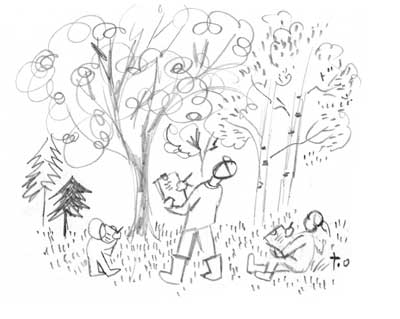 |
|
Drawing by Toki Oshima |
By Peter Hagerty, Low Impact Forestry Project
About 20 years ago a group of friends and I began a series of courses on a new form of logging. The Maine Organic Farmers and Gardeners Association supported our effort with classrooms and a woodlot. Since then over 1,000 students have attended Low Impact Forestry (LIF) courses in chainsaw safety and draft and mechanical methods of log extractions. We have learned a great deal, both from our accomplishments and our mistakes.
One topic we constantly address is the role the draft animal plays in the forest. I started working in 1974 for the industrial forest with a team rescued by the Society for the Prevention of Cruelty to Animals. Back then lots of “private contractors” – one or two person teams – ran crawler tractors and small skidders. My horses felt at home in this crowd. Today my town’s largest employers are companies running multiple forest operations with 50 to 60 employees each. Needless to say there are no feedbags to clip on at lunch.
One day last spring I went up back with my team and picked up my saw, but I was unable to pull the starter cord – not for lack of strength, but because over the winter I had read some powerful books that confused my thinking, including “The Hidden Life of Trees” by Peter Wohllenbon and “Beyond the Beauty Strip” by Mitch Lansky. I no longer saw the trees in my forest as boards and beams but as front line soldiers working to save the human race from climate change. Instead of cutting them down, I began to measure the amount of carbon they safely sequester in the forest floor.
MOFGA’s LIF Project is creating a curriculum so that others may learn to help trees do their work. We are learning that the science is not just about the trees but about the forest environment as a whole. What is becoming apparent is that “it is all about the soil.” Like organic farming, forest soil health is measured by moisture, compaction and microbial activity. Avoiding soil compaction is essential for trees to do their work of storing carbon in the ground. We continue to feature draft animals in the LIF curriculum as the most affordable and least damaging extraction method for the forest soils and ecosystem.
Let me emphasize that we are learning as we go, and we at LIF are just beginning to get a handle on the science behind this sequestration process. The implications of saving the big timber to mitigate climate change are complicated and may be a slow sale in a state like Maine. But when I close my eyes at night just before drifting off to sleep, I see my town in the not too distant future. I see high school students and teachers heading for the MOFGA campus where they will study the science of the forest environment and its relationship to the carbon crisis, and develop a skill set that they will take back to their own communities. They will go on to work with landowners developing a low-impact management plan that keeps trees doing the job they need to do: keeping the earth a place where all creatures can thrive. In the new forest, wildlife will be more abundant, water will be safer to drink and air will be better to breathe. And more feed bags will be hanging on the trees.
A Rough Calculation of Carbon in the MOFGA Forest
Tim Libby, Mitch Lansky and Sam Brown of MOFGA’s Low Impact Forestry Project have made a very approximate calculation that 2 acres of the Pine Lot in the MOFGA forest (near the Pine Gate entrance to the Common Ground Country Fair) hold more than 300 tons of carbon. That’s carbon in the living trees, dead trees, saplings, litter layer and soil. Every year those living trees put on another 3,000 pounds of carbon, sequestering from the air more than 11,000 pounds of CO2. The LIF Project members plan to calculate the amount of carbon in the rest of the MOFGA forest to further highlight the importance of low-impact forestry practices.
